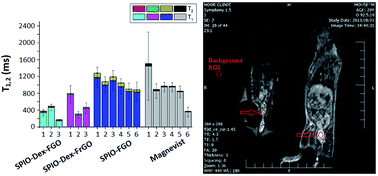Magnetite/dextran-functionalized graphene oxide nanosheets for in vivo positive contrast magnetic resonance imaging
Abstract
Superparamagnetic iron oxide (SPIO) nanomaterials are widely used as magnetic resonance imaging (MRI) contrast agents (CAs). These CAs significantly shorten transverse relaxation time (T2) and so decrease the intensity of the T2-weighted MRI (negative contrast imaging). However, the partial-volume effect is known to be one of the problems in negative contrast MRI. In this work, SPIO nanoparticles were modified by dextran and graphene oxide (GO) nanosheets to achieve a positive contrast MRI with high intensity. This modification resulted in shortening the longitudinal relaxation time (T1) of the SPIO nanoparticles (in addition to the T2 shortening). Using FLASH pulse sequence, T1-weighted positive contrast MRI of Wistar rats revealed that the SPIO/dextran-functionalized GO (SPIO-Dex-FGO) significantly enhanced the contrast to noise ratio (CNR) of the positive contrast MRI as compared to the common clinical positive CA, i.e., Magnevist®. In fact, based on the CNR calculations for in vivo positive contrast images it was found that the SPIO-Dex-FGO could provide the same CNR as Magnevist® at concentrations two orders of magnitudes lower than the concentrations used for Magnevist®. Therefore, SPIO-Dex-FGO can be proposed as a promising substitution for the current CAs such as Magnevist® in T1-weighted positive contrast MRI, at lower and safer concentrations.


 Please wait while we load your content...
Please wait while we load your content...